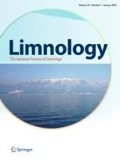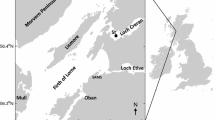Abstract
Analysis of ten- and four-year datasets for the large, shallow, subtropical, and eutrophic Lakes Okeechobee (USA) and Taihu (China), respectively, suggest that resource-ratio explanations for cyanobacteria dominance may not apply to these two lakes. Datasets were examined to identify relationships between nutrient ratios [total nitrogen (TN):total phosphorus (TP) and ammonium (NH4 +):oxidized N (NO x )] and phytoplankton community structure (as proportions of cyanobacteria and diatoms to total phytoplankton biomass). Datasets were pooled by sampling month, averaged lake-wide, and analyzed with linear regression. In Okeechobee, the cyanobacteria proportion increased and the diatom proportion decreased with increasing TN:TP. In Taihu, cyanobacteria decreased with increasing TN:TP, but the opposite trend observed for diatoms was marginally significant. Okeechobee cyanobacteria increased and diatoms decreased with increasing NH4 +:NO x , but no significant relationships between phytoplankton and NH4 +:NO x were observed in Taihu. Both lakes had significant relationships between phytoplankton community structure and total nutrients, but these relationships were the opposite of those expected. Relationships between phytoplankton community structure and water quality parameters from the previous month resulted in improved relationships, suggesting a predictive capability. Statistical analysis of the entire datasets (not pooled) supported these and additional relationships with other parameters, including temperature and water clarity.





Similar content being viewed by others
References
Aldridge FJ, Phlips EJ, Schelske CJ (1995) The use of nutrient enrichment bioassays to test for spatial and temporal distribution of limiting factors affecting phytoplankton dynamics in Lake Okeechobee, Florida. Arch Hydrobiol Spec Issue 45:177–190
An S, Gardner WS (2002) Dissimilatory nitrate reduction to ammonium (DNRA) as a nitrogen link, versus denitrification as a sink in a shallow estuary (Laguna Madre/Baffin Bay, Texas). Mar Ecol Prog Ser 237:41–50
APHA (1998) Standard methods for the examination of water and wastewater. American Public Health Association, American Water Works Association and Water Pollution Control Federation, Washington, DC
Barica J, Kling H, Gibson J (1980) Experimental manipulation of algal bloom composition by nitrogen addition. Can J Fish Aquat Sci 37:1175–1183
Berg GM, Balode M, Purina I, Bekere S, Béchemin C, Maestrini SY (2003) Plankton community composition in relation to availability and uptake of oxidized and reduced nitrogen. Aquat Microb Ecol 30:263–274
Blomqvist P, Pettersson A, Hyenstrand P (1994) Ammonium–nitrogen: a key regulatory factor causing dominance of non-nitrogen-fixing cyanobacteria in aquatic systems. Arch Hydrobiol 132:141–164
Cai Q, Gao X, Chen Y, Ma S, Dokulil M (1997) Dynamic variations of water quality in Lake Taihu and multivariate analysis of its influential factors. J Chin Geogr 7:72–82
Chen Q, Mynett AE (2003) Integration of data mining techniques and heuristic knowledge in fuzzy logic modeling of eutrophication in Taihu Lake. Ecol Modell 162:55–67
Chen Y, Fan C, Teubner K, Dokulil M (2003a) Changes of nutrients and phytoplankton chlorophyll-a in a large shallow lake, Taihu, China: an 8-year investigation. Hydrobiologia 506–509:273–279
Chen Y, Qin B, Teubner K, Dokulil M (2003b) Long-term dynamics of phytoplankton assemblages: Microcystis-domination in Lake Taihu, a large shallow lake in China. J Plankton Res 25:445–453
Dickman M, Pu P, Zheng C (1998) Taihu Lake: past, present and future. J Lake Sci (China) 10(Suppl):75–83
Dokulil MT, Teubner K (2000) Cyanobacterial dominance in lakes. Hydrobiologia 438:1–12
Downing JA, Watson SB, McCauley E (2001) Predicting cyanobacteria dominance in lakes. Can J Fish Aquat Sci 58:1905–1908
Elser JJ (1999) The pathway to noxious cyanobacteria blooms in lakes: the food web as the final turn. Freshw Biol 42:537–543
Elser JJ, Marzolf ER, Goldman CR (1990) Phosphorus and nitrogen limitation of phytoplankton growth in freshwaters of North America: a review and critique of experimental enrichments. Can J Fish Aquat Sci 47:1468–1477
Fisher MM, Reddy KR, James RT (2001) Long-term changes in the sediment chemistry of a large shallow subtropical lake. Lake Reserv Manage 17:217–232
Flaig EG, Havens KE (1995) Historical trends in the Lake Okeechobee ecosystem. I. Land use and nutrient loading. Arch Hydrobiol 107(Suppl):1–24
Flores E, Herrero A (2005) Nitrogen assimilation and nitrogen control in cyanobacteria. Biochem Soc Trans 33(1):164–167
Gardner WS, McCarthy MJ, An S, Sobolev D, Sell KS, Brock D (2006) Nitrogen fixation and dissimilatory nitrate reduction to ammonium (DNRA) support nitrogen dynamics in Texas estuaries. Limnol Oceanogr 51:558–568
Giani A, Bird DF, Prairie YT, Lawrence JF (2005) Empirical study of cyanobacterial toxicity along a trophic gradient of lakes. Can J Fish Aquat Sci 62:2100–2109
Gu B, Havens KE, Schelske CL, Rosen BH (1997) Uptake of dissolved nitrogen by phytoplankton in a eutrophic subtropical lake. J Plankton Res 19:759–770
Guo L (2007) Doing battle with the green monster of Taihu Lake. Science 317:1166
Havens KE (1995) Particulate light attenuation in a large subtropical lake. Can J Fish Aquat Sci 52:1803–1811
Havens KE (2000) Using trophic state index (TSI) values to draw inferences regarding phytoplankton limiting factors and seston composition from routine water quality monitoring data. Korean J Limnol 33:187–196
Havens KE, Bierman VJ, Jr, Flaig EG, Hanlon C, James RT, Jones BL, Smith VH (1995) Historical trends in the Lake Okeechobee ecosystem. VI. Synthesis. Arch Hydrobiol 107(Suppl):101–111
Havens KE, East TL, Beaver JR (1996) Experimental studies of zooplankton–phytoplankton–nutrient interactions in a large subtropical lake (Lake Okeechobee, Florida USA). Freshw Biol 36:579–597
Havens KE, James RT, East TL, Smith VH (2003) N:P ratios, light limitation, and cyanobacterial dominance in a subtropical lake impacted by non-point source nutrient pollution. Environ Pollut 122:379–390
Heath RT (1992) Nutrient dynamics in Great Lakes coastal wetlands: future directions. J Great Lakes Res 18(4):590–602
Heil CA, Revilla M, Glibert PM, Murasko S (2007) Nutrient quality drives differential phytoplankton community composition on the southwest Florida shelf. Limnol Oceanogr 52(3):1067–1078
Huang Y (2000) The water quality of Lake Taihu and its protection. In: Nanjing Institute of Geography and Limnology (ed) Research on lake sciences. Chinese Academy of Sciences, Beijing, pp 239–246
Hyenstrand P, Blomqvist P, Pettersson A (1998a) Factors determining cyanobacterial success in aquatic systems: a literature review. Arch Hydrobiol Spec Issue 51:41–62
Hyenstrand P, Nyvall P, Pettersson A, Blomqvist P (1998b) Regulation of non-nitrogen-fixing cyanobacteria by inorganic nitrogen sources–experiments from Lake Erken. Arch Hydrobiol Spec Issue 51:29–40
James RT, Smith VH, Jones BL (1995) Historical trends in the Lake Okeechobee ecosystem. III. Water quality. Arch Hydrobiol 107(Suppl):49–69
James RT, Chimney MJ, Sharfstein B, Engstrom DR, Schottler SP, East T, Jin K-R (2008) Hurricane effects on a shallow lake ecosystem, Lake Okeechobee, Florida (USA). Fundam Appl Limnol 172(4):273–287
James RT, Havens KE, Zhu G, Qin B (2009) Comparative analysis of nutrients, chlorophyll and transparency in two large shallow lakes (Lake Taihu, P.R. China and Lake Okeechobee, USA). Hydrobiologia. doi:10.1007/s10750-009-9729-5
Kappers FI (1980) The cyanobacterium Microcystis aeruginosa Kg. and the nitrogen cycle of the hypertrophic Lake Brielle (The Netherlands). In: Barica J, Mur L (eds) Hypertrophic ecosystems. Dr. W. Junk, The Hague, pp 37–43
Levine SN, Shambaugh AD, Pomeroy SE, Braner M (1997) Phosphorus, nitrogen, and silica as controls on phytoplankton biomass and species composition in Lake Champlain (USA–Canada). J Great Lakes Res 23:131–148
Litchman E (1998) Population and community responses of phytoplankton to fluctuating light. Oecologia 177:247–257
Maceina MJ, Soballe DM (1990) Wind-related limnological variation in Lake Okeechobee, Florida. Lake Reserv Manage 6:93–100
McCarthy JJ, Taylor WR, Taft JL (1977) Nitrogenous nutrition of the plankton in the Chesapeake Bay. 1. Nutrient availability and phytoplankton preferences. Limnol Oceanogr 22:996–1011
McCarthy MJ, Lavrentyev PJ, Yang L, Zhang L, Chen Y, Qin B, Gardner WS (2007) Nitrogen dynamics and microbial food web structure during a summer cyanobacterial bloom in a subtropical, shallow, well-mixed, eutrophic lake (Lake Taihu, China). Hydrobiologia 581:195–207
Nõges T, Laugaste R, Nõges P, Tõnno I (2008) Critical N:P ratio for cyanobacteria and N2-fixing species in the large shallow temperate lakes Peipsi and Võrtsjärv, North-East Europe. Hydrobiologia 599:77–86
North RL, Guildford SJ, Smith REH, Havens SM, Twiss MR (2007) Evidence for phosphorus, nitrogen, and iron colimitation of phytoplankton communities in Lake Erie. Limnol Oceanogr 52:315–328
Phlips EJ, Cichra M, Havens K, Hanlon C, Badylak S, Reuter B, Randall M, Hansen P (1997) Relationships between phytoplankton dynamics and the availability of light and nutrients in a shallow sub-tropical lake. J Plankton Res 19:319–342
Pick FR, Lean DRS (1987) The role of macronutrients (C, N, P) in controlling cyanobacterial dominance in temperate lakes. NZ J Mar Freshw Res 21:425–434
Pu P, Yan J (1998) Taihu Lake—a large shallow lake in the East China Plain. J Lake Sci (China) 10(Suppl):1–12
Rolland A, Bird DF, Giani A (2005) Seasonal changes in composition of the cyanobacterial community and the occurrence of hepatotoxic blooms in the eastern townships, Québec, Canada. J Plankton Res 27:683–694
Sagrario MAG, Jeppesen E, Goma J, Sondergaard M, Jensen JP, Lauridsen T, Landkildehus F (2005) Does high nitrogen loading prevent clear-water conditions in shallow lakes at moderately high phosphorus concentrations? Freshw Biol 50:27–41
Schindler DW (1974) Eutrophication and recovery in experimental lakes: implications for lake management. Science 184:897–899
Schindler DW (1977) Evolution of phosphorus limitation in lakes. Science 195:260–262
Schindler DW (2006) Recent advances in the understanding and management of eutrophication. Limnol Oceanogr 51(1, Pt 2):356–363
Seitzinger SP (1988) Denitrification in freshwater and coastal marine ecosystems: ecological and geochemical significance. Limnol Oceanogr 33:702–724
Shapiro J (1990) Current beliefs regarding dominance by blue-greens: the case for the importance of CO2 and pH. Int Verein Limnol 24:38–54
Shapiro J (1997) The role of carbon dioxide in the initiation and maintenance of blue-green dominance in lakes. Freshw Biol 37:307–323
Smith VH (1983) Low nitrogen to phosphorus ratios favor dominance by blue-green algae in lake phytoplankton. Science 221:669–671
Smith VH, Bennett SJ (1999) Nitrogen:phosphorus supply ratios and phytoplankton community structure in lakes. Arch Hydrobiol 146:37–53
Smith VH, Bierman VJ Jr, Jones BL, Havens KE (1995) Historical trends in the Lake Okeechobee ecosystem. IV. Nitrogen:phosphorus ratios, cyanobacterial dominance, and nitrogen fixation potential. Arch Hydrobiol 107(Suppl):71–88
Syrett PJ (1981) Nitrogen metabolism of microalgae. Can Bull Fish Aquat Sci 210:182–210
Takamura N, Iwakuma T, Yasuno M (1987) Uptake of 13C and 15 N (ammonium, nitrate and urea) by Microcystis in Lake Kasumigaura. J Plankton Res 9:151–165
Tilman D, Kiesling R, Sterner R, Kilham SS, Johnson FA (1986) Green, bluegreen and diatom algae: taxonomic differences in competitive ability for phosphorus, silicon and nitrogen. Arch Hydrobiol 106:473–485
US Environmental Protection Agency (USEPA) (1983) Methods for chemical analysis of water and wastes. USEPA, Washington, DC
Vallino JJ, Hopkinson CS, Hobbie JE (1996) Modeling bacterial utilization of dissolved organic matter: optimization replaces Monod growth kinetics. Limnol Oceanogr 41:1591–1609
Vant WN, Hua YZ, Jiang YC, McBride GB, Roper DS, Wang Q (1998) Analysis of Lake Taihu eutrophication data, 1989–1993. J Lake Sci (China) 10(Suppl):143–154
Vrede K, Hyenstrand P, Pettersson A, Blomqvist P (1998) The response of heterotrophic bacterioplankton to different forms of inorganic nitrogen. Arch Hydrobiol (Special Issue on Lake Erken) 51:213–222
Xie L, Xie P, Li S, Tang H, Liu H (2003) The low TN:TP ratio, a cause or a result of Microcystis blooms? Water Res 37:2073–2080
Yang L, Qin B, Hu W, Luo L, Song Y (2007) The atmospheric deposition of nitrogen and phosphorus nutrients in Taihu Lake. Oceanol Limnol Sin 38:104–110
Acknowledgments
This project was supported by the Chinese Academy of Sciences, the Nancy Lee and Perry R. Bass Regents Chair in Marine Science, NOAA Coastal Oceans Program, South Florida Water Management District, and the US National Science Foundation—International and Chemical Oceanography Programs. Additional Chinese collaborators included Dr. Qin Boqiang, Dr. Zhang Lu, and Mr. Yang Longyuan, and their assistance is greatly appreciated. The authors thank Dr. Robert T. Heath, Paul McCormick, Mike Chimney, Andrew Rodusky, and Greg Graves for valuable comments on the manuscript. The authors also would like to thank Shin Nakayama for translating the abstract to Japanese.
Author information
Authors and Affiliations
Corresponding author
Rights and permissions
About this article
Cite this article
McCarthy, M.J., James, R.T., Chen, Y. et al. Nutrient ratios and phytoplankton community structure in the large, shallow, eutrophic, subtropical Lakes Okeechobee (Florida, USA) and Taihu (China). Limnology 10, 215–227 (2009). https://doi.org/10.1007/s10201-009-0277-5
Received:
Accepted:
Published:
Issue Date:
DOI: https://doi.org/10.1007/s10201-009-0277-5




